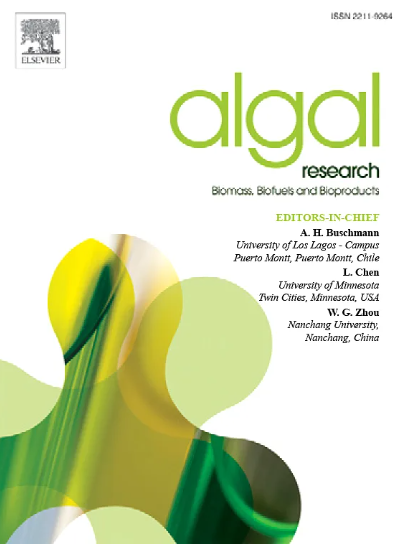Coordinated carbon and nitrogen metabolism in attaining iron homeostasis in the unicellular N2-fixing cyanobacterium Crocosphaera watsonii WH8501
IF 4.5
2区 生物学
Q1 BIOTECHNOLOGY & APPLIED MICROBIOLOGY
Algal Research-Biomass Biofuels and Bioproducts
Pub Date : 2025-07-30
DOI:10.1016/j.algal.2025.104249
引用次数: 0
Abstract
Marine diazotrophic cyanobacteria are ocean's primary producers and suppliers of “new” nitrogen (N) due to their capability to perform both photosynthesis and N2 fixation, which require iron (Fe)—an extremely scarce trace metal in world's surface ocean—as a cofactor. While enhanced phytoplankton growth as a result of Fe fertilization has been frequently encountered, how marine diazotrophs adjust basal physiology and metabolism in response to varied Fe availability, particularly from a single-cell perspective, remains elusive. Here we show coordinated carbon (C) and N metabolism in sustaining Fe homeostasis in the unicellular N2-fixing cyanobacterium Crocosphaera watsonii WH8501. Fe deficiency inhibited cell growth, photosynthesis and N2 fixation, leading to a decrease in the content of particulate organic C and N. However, the C:N ratio in the Fe-deficient cells was significantly higher than that in the Fe-replete cells, coinciding with a greater reduction in metalloenzyme inventory associated with N metabolism than with C metabolism. Intriguingly, Fe deficiency caused C flux toward Fe-independent glycolysis and bypassing the Fe-dependent tricarboxylic acid cycle so that Fe can be reallocated to superoxide dismutase to maintain redox balance. Meanwhile, upregulation of the nitrate/nitrite assimilation enzymes under Fe deficiency further alleviated the high Fe demand of N2 fixation. Taken together, this study highlights physiological basis underpinning Crocosphaera phenotypic plasticity in regulating central metabolism to acclimatize Fe availability, which is of important reference in assessing marine diazotrophs adaptation to changing marine ecosystem.
碳氮协调代谢在单细胞固氮蓝藻鳄watsonii WH8501中实现铁稳态
海洋重氮营养蓝藻是海洋中“新”氮(N)的主要生产者和供应者,因为它们具有进行光合作用和固氮的能力,这需要铁(Fe)作为辅助因子,铁(Fe)是世界表层海洋中极其稀缺的微量金属。虽然经常遇到由于铁施肥而促进浮游植物生长的情况,但海洋重氮营养体如何调节基础生理和代谢以响应不同的铁可用性,特别是从单细胞的角度来看,仍然是难以捉摸的。在这里,我们展示了碳(C)和氮的协调代谢在维持单细胞固定氮的蓝藻鳄鱼watsonii WH8501中的铁稳态。缺铁抑制了细胞生长、光合作用和N2固定,导致颗粒有机C和N含量降低,缺铁细胞的C:N比值显著高于富铁细胞,与N代谢相关的金属酶库存量比与C代谢相关的金属酶库存量减少更大。有趣的是,缺铁导致C流向不依赖铁的糖酵解,绕过依赖铁的三羧酸循环,使铁可以重新分配给超氧化物歧化酶以维持氧化还原平衡。同时,缺铁条件下硝酸盐/亚硝酸盐同化酶的上调进一步缓解了固氮对铁的高需求。综上所述,本研究揭示了鳄鱼表型可塑性调节中枢代谢以适应铁有效性的生理基础,为评估海洋重氮营养体对海洋生态系统变化的适应性提供了重要参考。
本文章由计算机程序翻译,如有差异,请以英文原文为准。
求助全文
约1分钟内获得全文
求助全文
来源期刊

Algal Research-Biomass Biofuels and Bioproducts
BIOTECHNOLOGY & APPLIED MICROBIOLOGY-
CiteScore
9.40
自引率
7.80%
发文量
332
期刊介绍:
Algal Research is an international phycology journal covering all areas of emerging technologies in algae biology, biomass production, cultivation, harvesting, extraction, bioproducts, biorefinery, engineering, and econometrics. Algae is defined to include cyanobacteria, microalgae, and protists and symbionts of interest in biotechnology. The journal publishes original research and reviews for the following scope: algal biology, including but not exclusive to: phylogeny, biodiversity, molecular traits, metabolic regulation, and genetic engineering, algal cultivation, e.g. phototrophic systems, heterotrophic systems, and mixotrophic systems, algal harvesting and extraction systems, biotechnology to convert algal biomass and components into biofuels and bioproducts, e.g., nutraceuticals, pharmaceuticals, animal feed, plastics, etc. algal products and their economic assessment
 求助内容:
求助内容: 应助结果提醒方式:
应助结果提醒方式:


